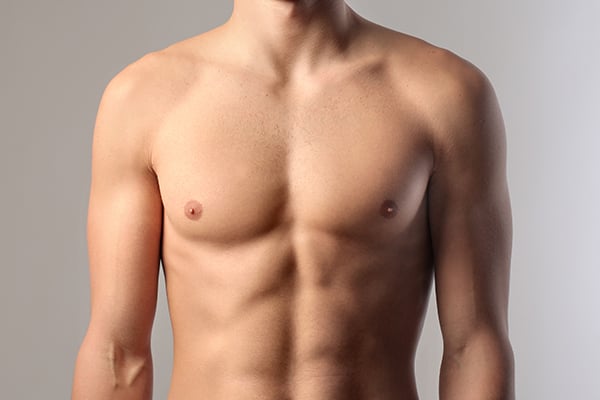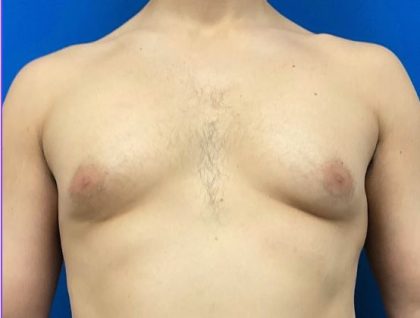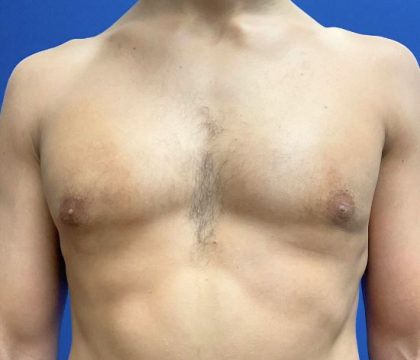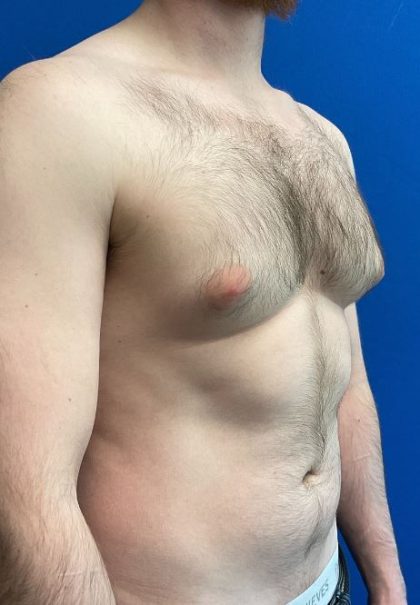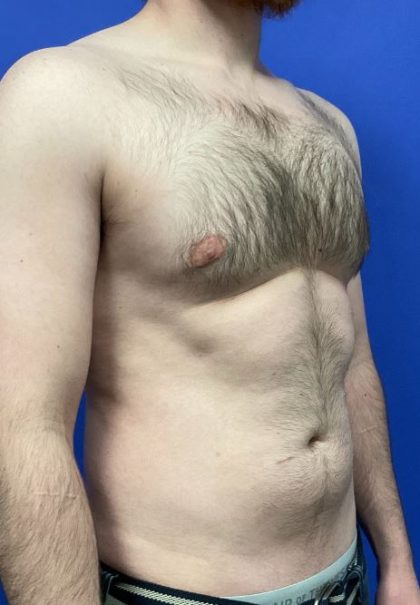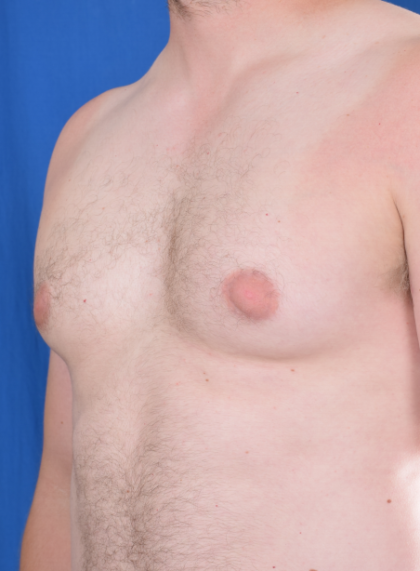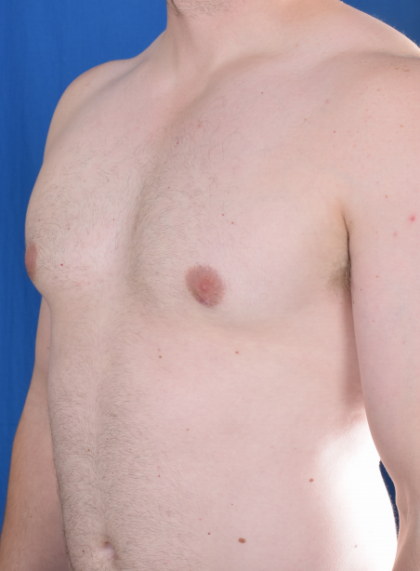Gynecomastia is the enlargement of the breast tissue in men. It can affect one or both breasts. This condition can stem from several lifestyle or medical causes. If you’ve noticed an increase in the area around either of your nipples, you may be experiencing gynecomastia. It is an embarrassing and uncomfortable situation for men to deal with, but it can also signal more serious health issues. It’s critical to consult a doctor to make sure that there aren’t serious medical conditions or underlying diseases that could be causing this growth. Male breasts can be the result of excess fat, “pseudo-gynecomastia.” However in some cases, an enlarged breast can be the result of a tumor. Only an experienced medical professional will be able to diagnose gynecomastia and determine the cause of this change in your appearance. If gynecomastia is to blame, there are effective and permanent ways to regain a smooth, masculine chest.
Dr. John Millard and the staff at the Millard Plastic Surgery Center are dedicated to their patients, and can eliminate the appearance of this condition. If you or a loved one may be experiencing this condition, schedule a friendly consultation with us by calling (303) 792-5665.
About Gynecomastia

The male breast contains small amounts of adipose and glandular tissue. When there is an increase in estrogen or progesterone levels and not enough testosterone, the glandular tissue can grow. This hormone imbalnakce can be caused by many factors. It can be caused by medical conditions such as cirrhosis of the liver, or use of certain medications, supplements, and illicit drugs. A condition called “pseudo gynecomastia” can also happen when the accumulation of fat tissue, rather than glandular tissue, occurs. This is often caused by obesity and can remain even after weight loss. [1]
Before and After Photos
Causes of Gynecomastia
Estrogen
Some men experience a high amount of estrogen that is higher than normal. Male estrogen levels that are too high or are just out of balance with testosterone levels cause gynecomastia. It isn’t necessarily harmful, but it does cause an increase in breast tissue.
Klinefelter Syndrome
This is a genetic occurrence that causes males to be born with an extra X chromosome, which is the female chromosome. For men, this will show as XXY. [2] Symptoms can be subtle and often, people are unaware of this condition. Symptoms may include less body hair, less muscle mass, and enlarged breasts.
Hyperthyroidism
The thyroid gland plays a vital role in our bodies. It regulates our metabolism and hormone production. When it’s overactive, more hormones are produced to compensate. [3]
Aging
Aging causes men’s testosterone levels to naturally decrease, which can lead to excess levels of estrogen. Aging, loose skin can exacerbate the appearance of gynecomastia.
Prescriptions, Steroids, and Other Drugs
Certain prescribed medications can result in gynecomastia as a side effect. Anabolic steroid use and similar drugs are a big contributor to gynecomastia in bodybuilders. Marijuana, amphetamines, and other illicit drugs can also alter hormonal production and increase breast tissue.
Getting a Diagnosis
Because of the many factors that can lead to breast development, doctors perform comprehensive testing when treating a male patient with a swollen chest.
These examinations and tests may include:
- Full physical examination
- Blood work to check hormone and other levels
- Manual examination of the breasts
- Testicular examination
- Ultrasound or X Ray
It’s important to share any symptoms you’ve been experiencing, even if they seem unrelated to your chest. Be prepared to discuss your lifestyle honestly so that the doctor can make an accurate diagnosis. Your health depends upon it.
Treating Gynecomastia
Once it’s been determined that gynecomastia is to blame for your overdeveloped chest, your doctor may adjust medications, balance your hormone levels, or suggest lifestyle changes.
However, even after slowing growth and balancing hormones, men still may be left with lingering breasts. Men looking for a better-contoured body will benefit from a male breast reduction surgery.
Good candidates include:
- Men whose condition cannot be corrected through alternative treatments
- Healthy individuals without serious medical conditions
- Nonsmokers and non-drug users
- Have a positive outlook and goals in mind to improve the symptoms of gynecomastia
- Physically healthy individuals
- Those within 30 pounds of their ideal weight
- Have realistic expectations
To better understand how surgical procedures can treat gynecomastia, feel free to schedule a consultation with us. Dr. Millard will gladly discuss the details with you to ensure you are a good fit for the treatment.
Benefits to Male Breast Reduction Surgery
Dr. Millard may use either liposuction or VASER High Definition Liposuction to eliminate the appearance of this tissue formation in men. Removing this unwanted problem not only reduces the size of the breast and prevents it from recurring, but can decrease the size of the areola, which is often stretched out from the excess tissue. Liposuction provides minimal scarring and allows Dr. Millard to sculpt a masculine contour based on your profile. VASER Hi-Def Liposuction uses ultrasound technology to break down stubborn fat deposits in the chest.
After surgery, results include:
- A flatter, contoured, and more masculine chest
- Firmer, tighter chest skin
- Clothing fits better
- Increased their confidence
Choosing to undergo a male breast reduction procedure may not be a thrilling decision to have to make, but you will reap benefits in the long run. Your quality of life will improve as you regain self-acceptance and confidence. Take the first step in reclaiming your life and schedule a consultation with us in Englewood or call (303) 792-5665.
Consultation

Denver’s top plastic surgeon Dr. John A. Millard is at your service. He and his helpful staff provide compassionate, friendly service to everyone who walks through our doors. He is a sought-after lecturer and teacher featured on prominent shows like Good Morning America, The Today Show, and The Doctors. During your consultation, he will address your concerns about your chest. Then, Dr. Millard will examine how male breast reduction surgery can benefit you. If deemed a good candidate, he will discuss the results of other gynecomastia patients who have benefitted from the surgery. Men interested in seeing if male breast reduction surgery is right for them should pencil in a consultation with our office. Learn more about the surgical process with our educational videos. Also, keep on top of other surgical methods on our blog.
Preparation
During your consultation, you will get detailed instructions on how to best prepare for your surgery. Directions are tailored to your specific needs.
When preparing for the male breast reduction surgery, you may be asked to:
- Avoid taking certain medications
- Avoid taking aspirin, anti-inflammatory drugs, and herbal supplements
- Quit smoking before your surgery
Procedure
Gynecomastia surgery is not a “one size fits all” procedure. Your path to an optimized chest will depend on the severity of the problem. The procedure usually takes about 1-2 hours to complete.[4] There are several different methods of liposculpture, and Dr. Millard will discuss the best option for you.
Liposuction
Liposuction is effective in treating gynecomastia and pseudo gynecomastia. Dr. Millard will make small incisions at the side of your chest or armpit. The specialized liposuction device removes excess fat and glandular tissue. [5] For cases of extensive sagging or stretched skin, excisions may be performed to remove the excess tissue and tighten the newly flattened chest.
VASER Hi-Def Lipo
VASER Hi-Def Liposuction uses ultrasound technology and allows Dr. Millard to sculpt an ideal masculine chest. First, a solution is injected into the targeted area that amplifies the effect of ultrasound waves, which break down the fat, making it easier to remove. [6] Small probes will be inserted in the area to generate the ultrasonic waves, which also serve to tighten the skin as the fat is eliminated.
Recovery
Liposuction is an outpatient procedure, and patients are advised to arrange for a loved one or a trusted friend to take them home and assist them for the next 24 hours. Dressings and a compression garment will be applied to further support your chest during recovery. The drains and sutures are usually removed during your follow-up appointment two weeks following surgery. Expect to see slight bruising or tenderness around the treatment site, however, this will subside as you continue to heal. We will prescribe you pain management medication to minimize discomfort. Your normal activities can be continued within 3-4 days and vigorous activity within three weeks.
Results
Visible results of a flatter, contoured chest may be seen right away, however, your final results will be visible in 3-6 months. By then, post-surgical swelling and incision lines will have faded. The surgical procedure provides permanent results as long as you maintain a stable body weight and healthy lifestyle.
Cost
The cost of your gynecomastia procedure is tailored to your needs and the extent of your condition. Dr. Millard and the team will go over this during your consultation. Financing options are available for those who qualify. Make sure to check out our specials page for deep savings.
References
- Dickson, G. (2012). Gynecomastia. American Family Physician, 85(7), 716–722. http://www.aafp.org/afp/2012/0401/p716.html
- Gynaecomastia. Information about Gynaecomastia. (n.d.). Patient.info; Egton Medical Information Systems Limited. Retrieved June 7, 2021, from https://patient.info/doctor/gynaecomastia
- Gynecomastia. (n.d.). ; Endocrine Society. Retrieved June 7, 2021, from https://www.hormone.org/diseases-and-conditions/gynecomastia
- Swerdloff, R. S., & Chiu Ming Ng. (2019, July 7). Gynecomastia: Etiology, Diagnosis, and Treatment. Nih.gov; MDText.com, Inc. https://www.ncbi.nlm.nih.gov/books/NBK279105/
- Rasko, Y. M., Rosen, C., Ngaage, L. M., AlFadil, S., Elegbede, A., Ihenatu, C., Nam, A. J., & Slezak, S. (2019). Surgical Management of Gynecomastia: A Review of the Current Insurance Coverage Criteria. Plastic and Reconstructive Surgery, 143(5), 1361–1368. https://doi.org/10.1097/PRS.0000000000005526
- Venkata Ratnam, B. (2010). How Important Is “Pseudogynecomastia”?. Aesthetic Plastic Surgery, 35(4), 668–669. https://doi.org/10.1007/s00266-010-9629-0
